Analysis and Design of Asymmetric Mid-Range Wireless Power Transfer System with Metamaterials
Abstract
1. Introduction
2. Design of Mid-Range WPT Systems with MMs
2.1. Theoretical Analysis
2.2. Design of WPT System and MNM-MM
3. Experimental Results
4. Conclusions
Author Contributions
Funding
Institutional Review Board Statement
Informed Consent Statement
Conflicts of Interest
References
- Hoang, H.; Lee, S.; Kim, Y.; Choi, Y.; Bien, F. An adaptive technique to improve wireless power transfer for consumer electronics. IEEE Trans. Consum. Electron. 2012, 58, 327–332. [Google Scholar] [CrossRef]
- Cai, C.; Wang, J.; Liu, R.; Fang, Z.; Zhang, P.; Long, M.; Hu, M.; Lin, Z. Resonant wireless charging system design for 110 kv high voltage transmission line monitoring equipment. IEEE Trans. Ind. Electron. 2019, 66, 4118–4129. [Google Scholar] [CrossRef]
- Liu, C.; Jiang, C.; Song, J.; Chau, K.T. An effective sandwiched wireless power transfer system for charging implantable cardiac pacemaker. IEEE Trans. Ind. Electron. 2019, 66, 4108–4117. [Google Scholar] [CrossRef]
- Basar, M.R.; Ahmad, M.Y.; Cho, J.; Ibrahim, F. Stable and high-efficiency wireless power transfer system for robotic capsule using a modified helmholtz coil. IEEE Trans. Ind. Electron. 2017, 64, 1113–1122. [Google Scholar] [CrossRef]
- Liu, M.; Fu, M.; Wang, Y.; Ma, C. Battery cell equalization via megahertz multiple-receiver wireless power transfer. IEEE Trans. Power Electron. 2018, 33, 4135–4144. [Google Scholar] [CrossRef]
- Ahn, D.; Hong, S. A study on magnetic field repeater in wireless power transfer. IEEE Trans. Ind. Electron. 2013, 60, 360–371. [Google Scholar] [CrossRef]
- Park, C.; Lee, S.; Cho, G.H.; Chun, T.M. Innovative 5-m-off-distance inductive power transfer systems with optimally shaped dipole coils. IEEE Trans. Power Electron. 2015, 30, 817–827. [Google Scholar] [CrossRef]
- Choi, B.H.; Thai, V.X.; Lee, E.S.; Kim, J.H.; Rim, C.T. Dipole-coil-based wide-range inductive power transfer systems for wireless sensors. IEEE Trans. Ind. Electron. 2016, 63, 3158–3167. [Google Scholar] [CrossRef]
- Pendry, J.B. Negative refraction makes a perfect lens. Phys. Rev. Lett. 2000, 85, 3966–3969. [Google Scholar] [CrossRef] [PubMed]
- Shelby, R.A.; Smith, D.R.; Schultz, S. Experimental verification of a negative index of refraction. Science 2001, 292, 77–79. [Google Scholar] [CrossRef] [PubMed]
- Pham, T.S.; Ranaweera, A.K.; Lam, V.D.; Lee, J.W. Experiments on localized wireless power transmission using a magneto-inductive wave two-dimensional metamaterial cavity. Appl. Phys. Express 2016, 9, 044101. [Google Scholar] [CrossRef]
- Cho, Y.; Kim, J.J.; Kim, D.H.; Lee, S.; Kim, H.; Song, C.; Kong, S.; Kim, H.; Seo, C.; Ahn, S.; et al. Thin pcb-type metamaterials for improved efficiency and reduced emf leakage in wireless power transfer systems. IEEE Trans. Microw. Theory Tech. 2016, 64, 353–364. [Google Scholar] [CrossRef]
- Pham, T.S.; Ranaweera, A.K.; Ngo, D.V.; Lee, J.W. Analysis and experiments on fano interference using a 2D metamaterial cavity for field localized wireless power transfer. J. Phys. D Appl. Phys. 2017, 50, 1–10. [Google Scholar] [CrossRef]
- Urzhumov, Y.; Smith, D.R. Metamaterial-enhanced coupling between magnetic dipoles for efficient wireless power transfer. Phys. Rev. B 2011, 83, 205114. [Google Scholar] [CrossRef]
- Huang, D.; Urzhumov, Y.; Smith, D.R.; Teo, K.H.; Zhang, J. Magnetic superlens-enhanced inductive coupling for wireless power transfer. J. Appl. Phys. 2012, 111, 064902. [Google Scholar] [CrossRef]
- Wang, B.; Teo, K.H.; Nishino, T.; Yerazunis, W.; Barnwell, J.; Zhang, J. Wireless power transfer with metamaterial. In European Conference on Antennas and Propagation; Palazzo dei Congressi: Rome, Italy, 2011. [Google Scholar]
- Ranaweera, A.L.A.K.; Duong, T.P.; Lee, J.W. Experimental investigation of compact metamaterial for high efficiency mid-range wireless power transfer applications. J. Appl. Phys. 2014, 116, 83–86. [Google Scholar] [CrossRef]
- Rong, C.C.; Tao, X.; Lu, C.H.; Hu, Z.; Huang, X.; Zeng, Y.Q.; Liu, M.H. Analysis and optimized design of metamaterials for mid-range wireless power transfer using a class-E RF power amplifier. Appl. Sci. 2018, 9, 26. [Google Scholar] [CrossRef]
- Jiang, C.; Chau, K.T.; Liu, C.; Lee, C.H.T. An overview of resonant circuits for wireless power transfer. Energies 2017, 10, 894. [Google Scholar] [CrossRef]
- Liu, S.; Chen, L.; Zhou, Y.; Cui, T.J. A general theory to analyse and design wireless power transfer based on impedance matching. Int. J. Electron. 2014, 101, 1375–1404. [Google Scholar] [CrossRef]
- Babic, S.; Sirois, F.; Akyel, C.; Girardi, C. Mutual inductance calculation between circular filaments arbitrarily positioned in space: Alternative to grover’s formula. IEEE Trans. Magn. 2010, 46, 3591–3600. [Google Scholar] [CrossRef]
- Conway, J.T. Inductance Calculations for Noncoaxial Coils Using Bessel Functions. IEEE Trans. Magn. 2007, 43, 1023–1034. [Google Scholar] [CrossRef]
- Rong, C.C.; Lu, C.H.; Tao, X.; Huang, X.; Zeng, Y.Q.; Liu, X.B.; Liu, M.H. Equivalent circuit method for Mu-Negative-Magnetic and Mu-Near-Zero metamaterials in wireless power transfer system. IET Power Electron. 2020, 13, 3056–3064. [Google Scholar] [CrossRef]


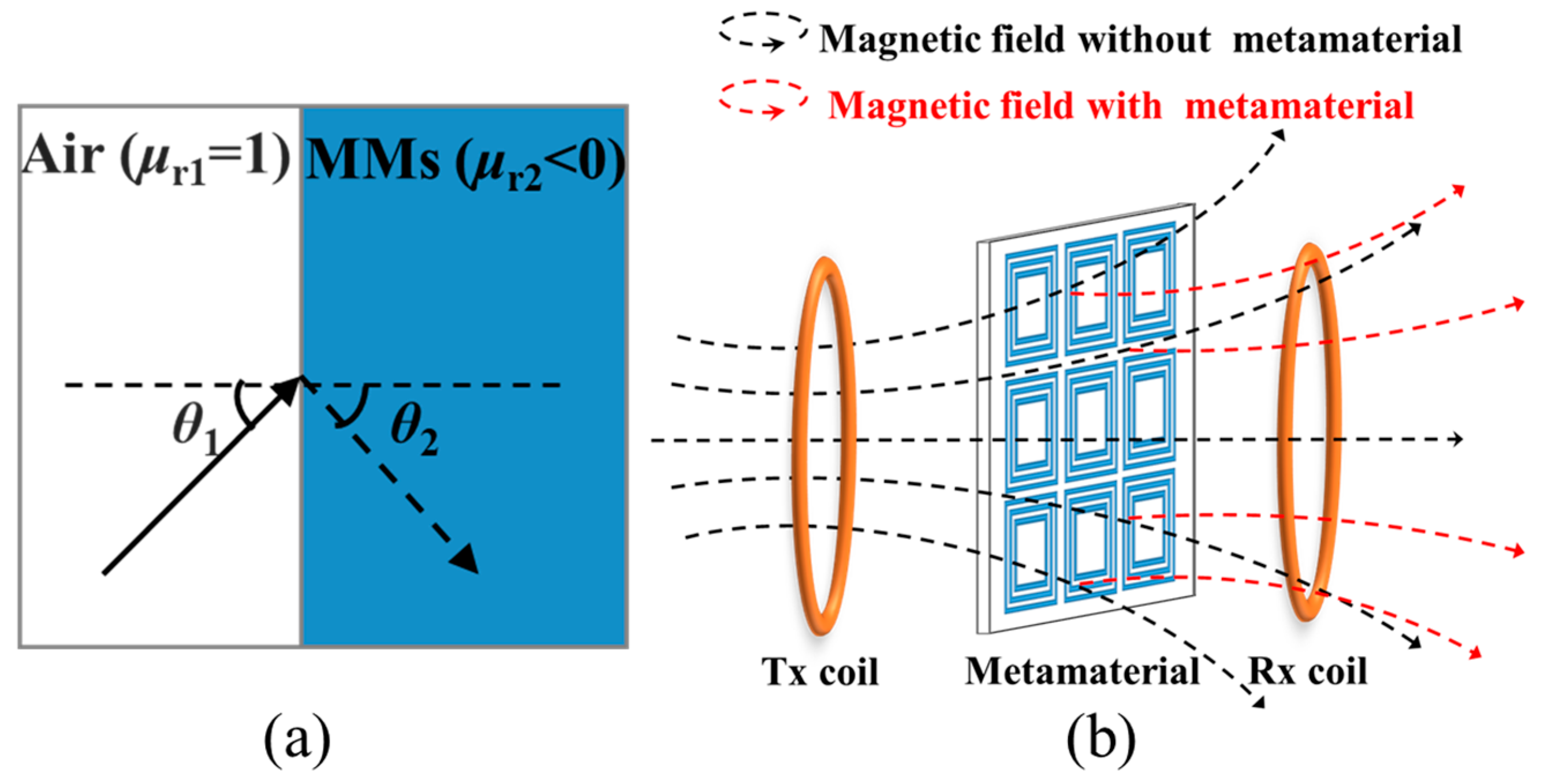
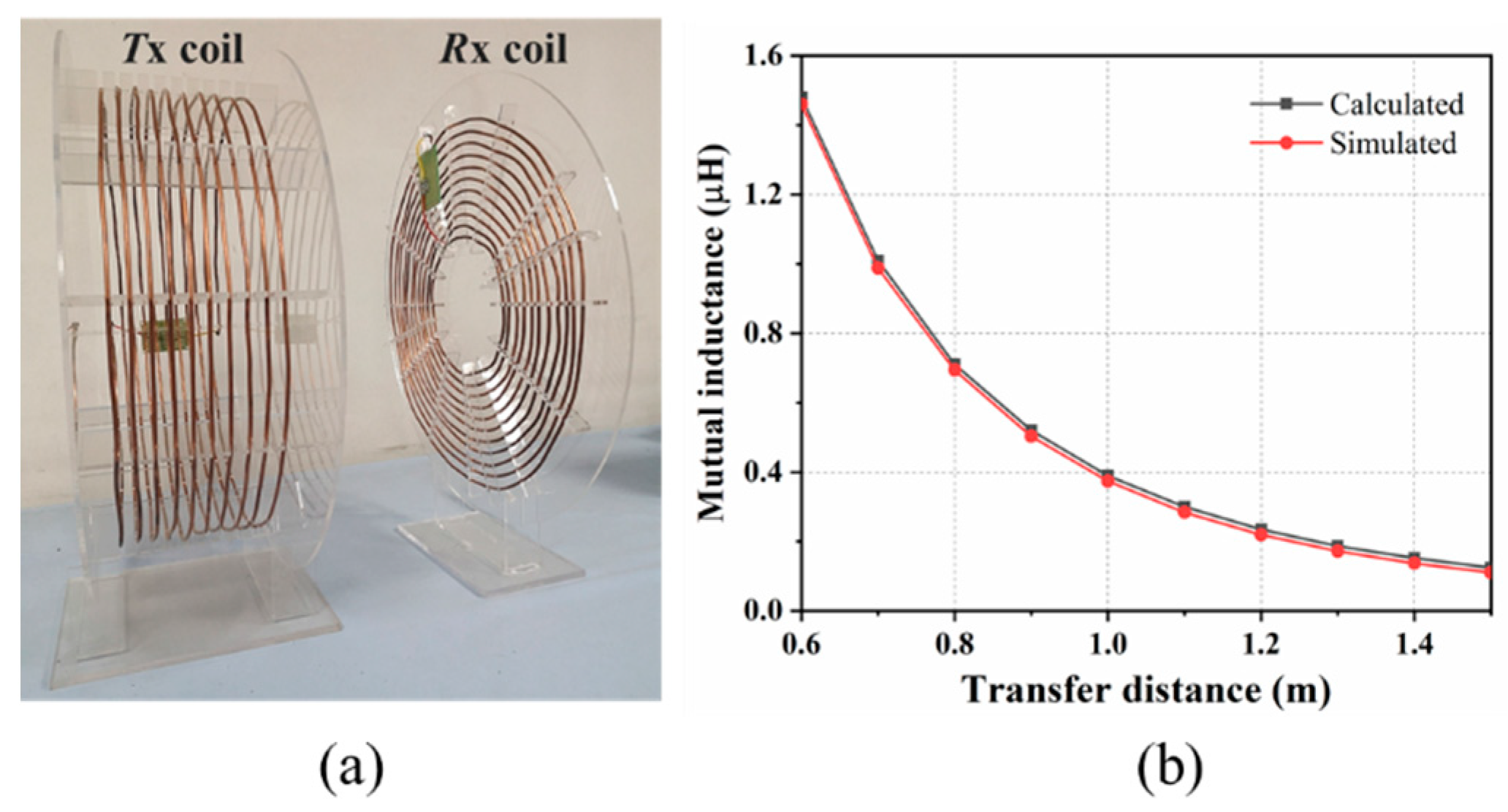
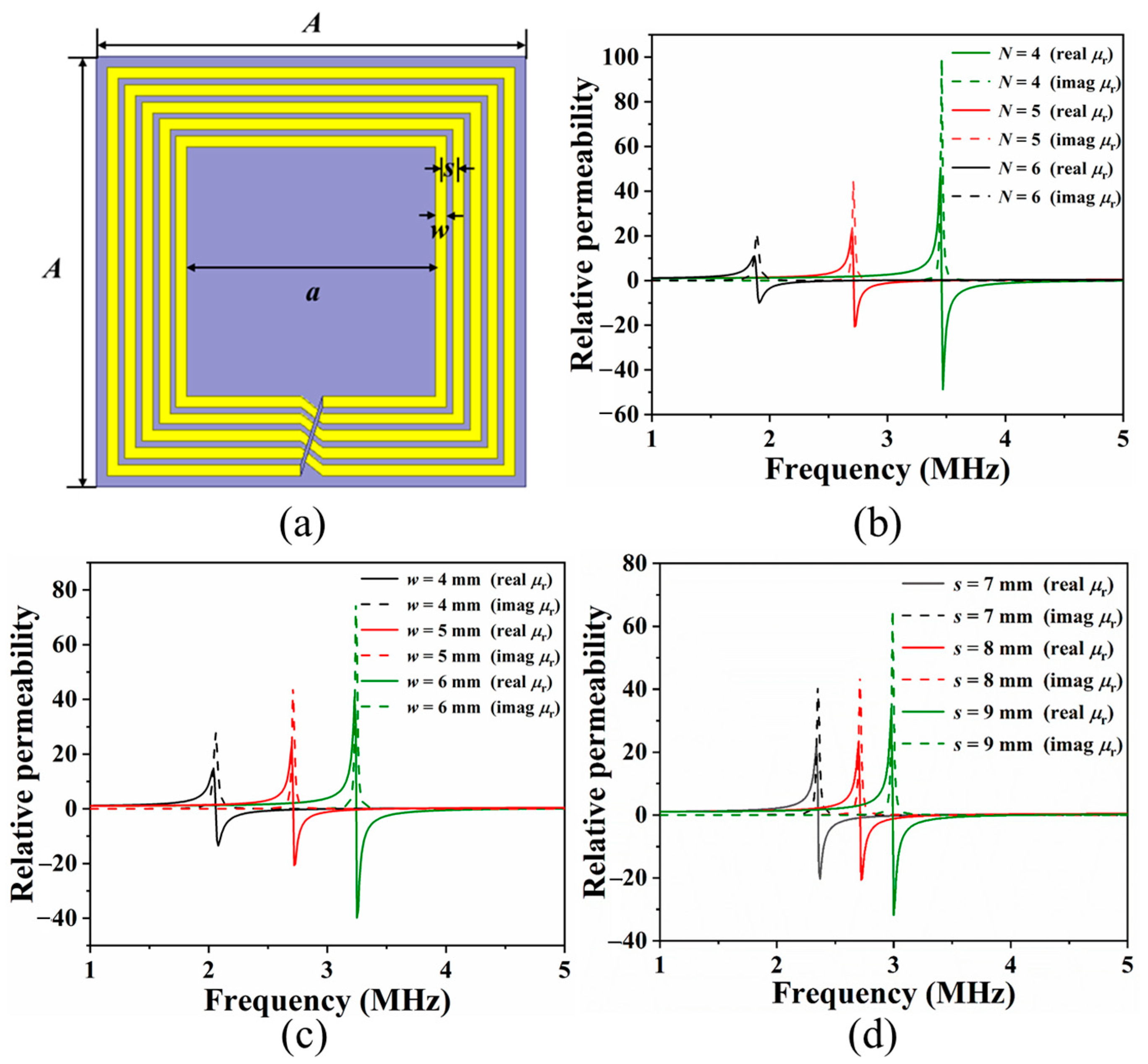
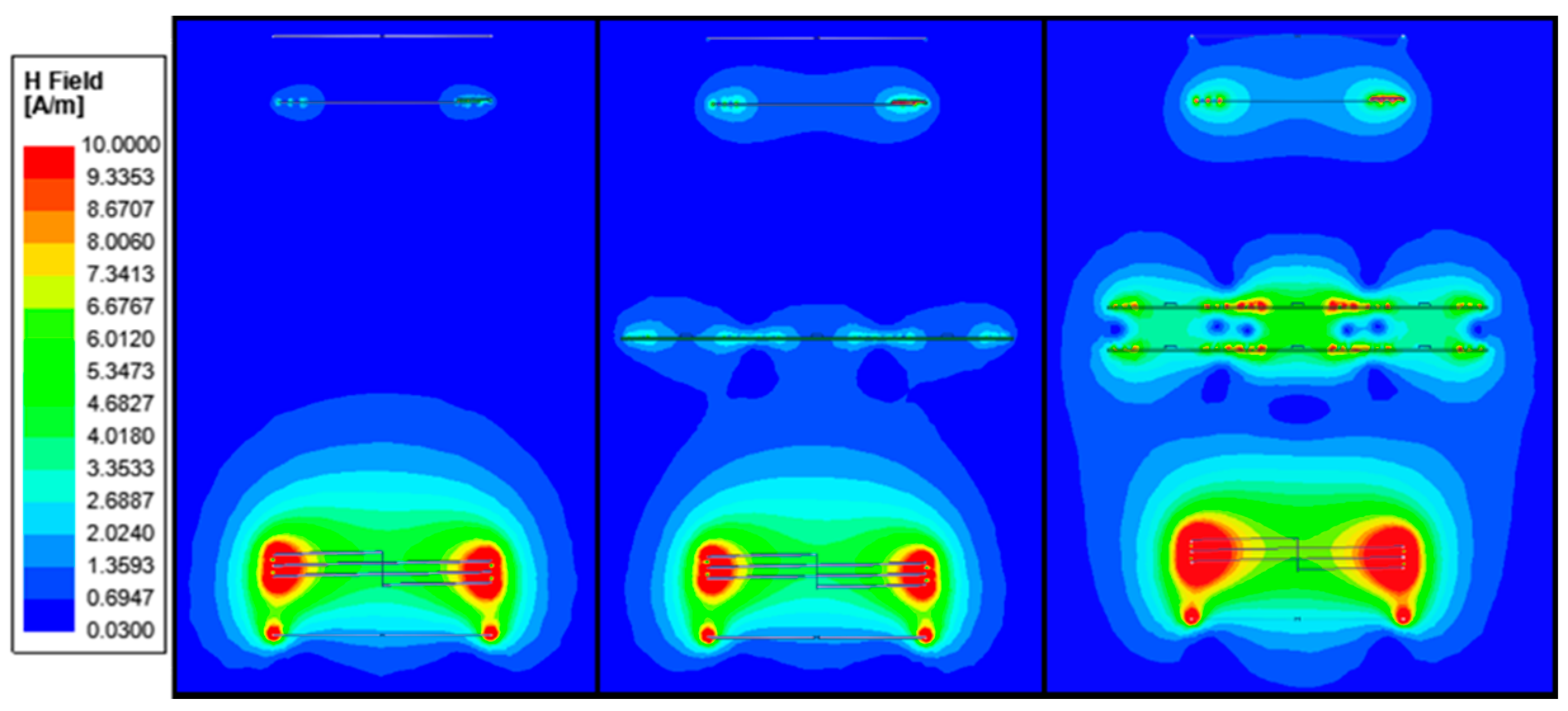

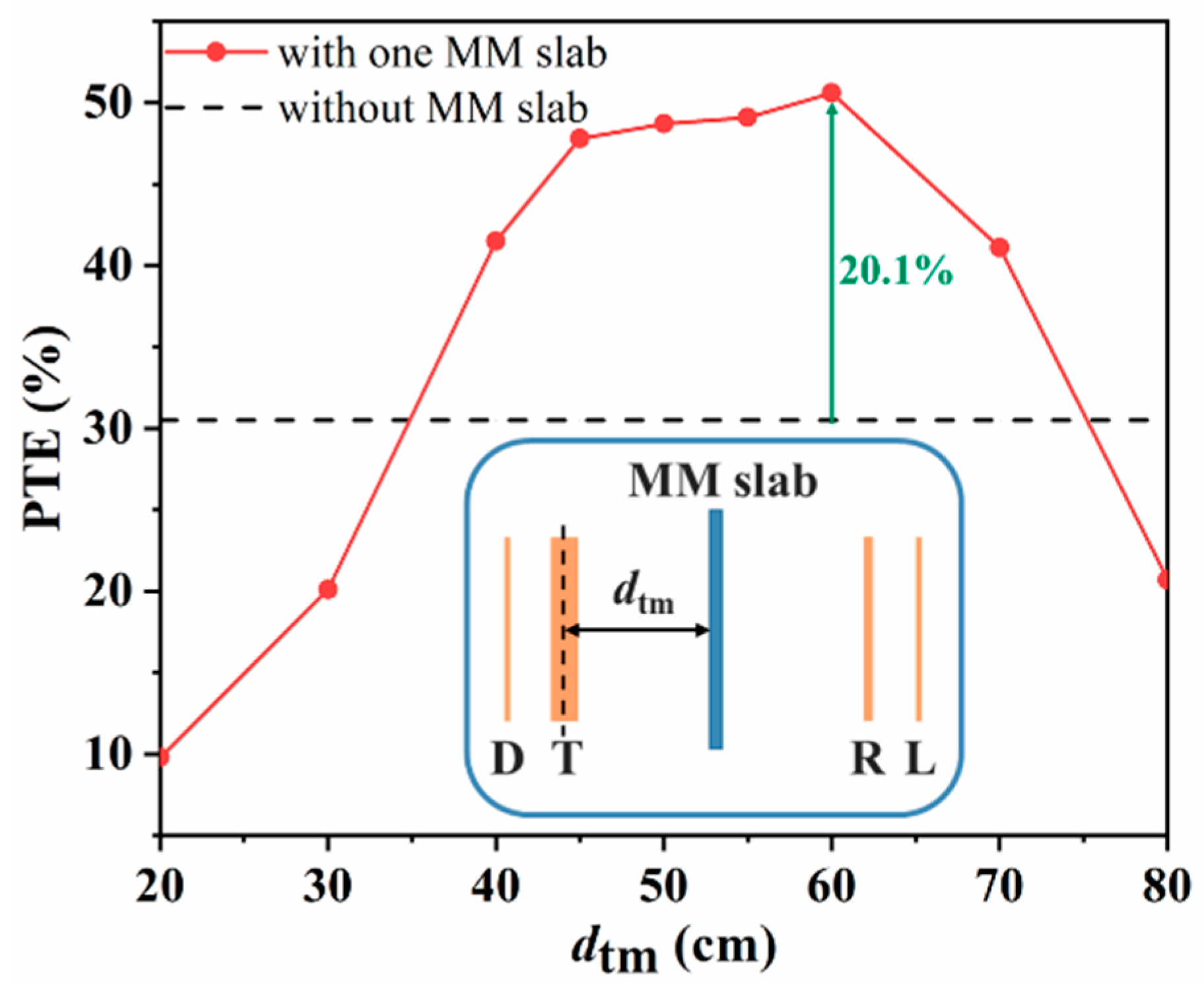
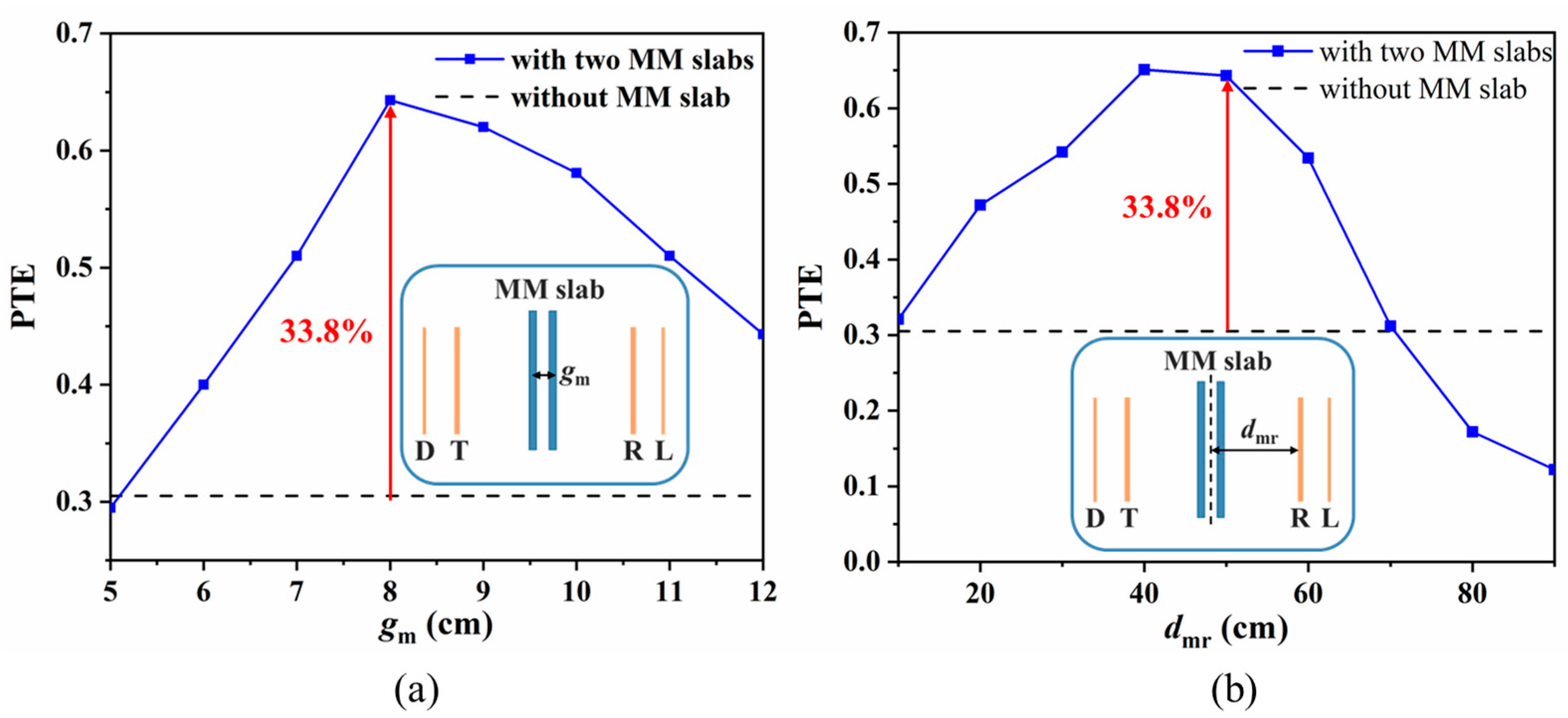

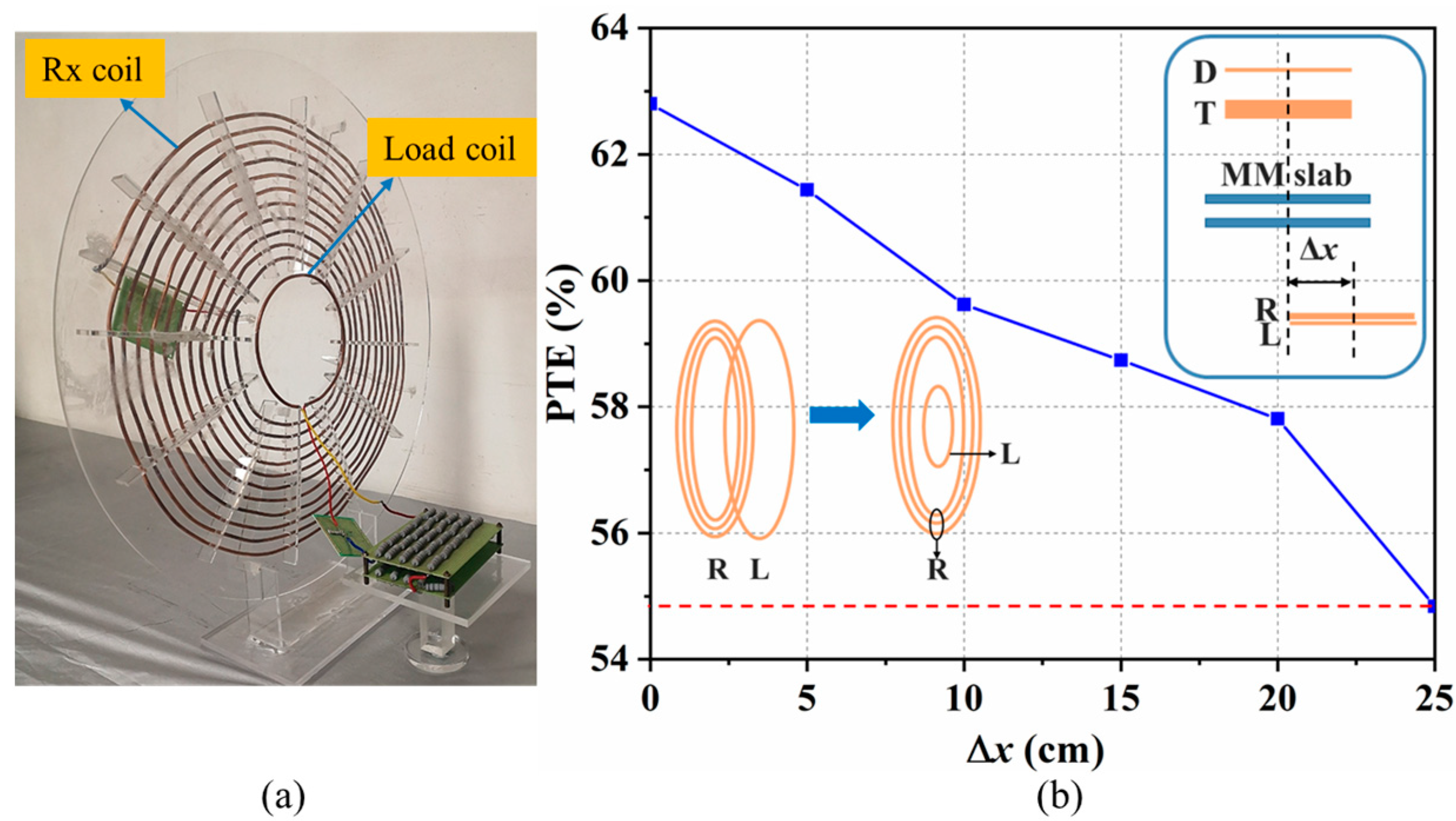

| Coil Type | Self-Inductance (μH) | Resistance (Ω) | Resonance Frequency (MHz) |
|---|---|---|---|
| Drive coil | 1.56 | 0.25 | 3 |
| Tx coil | 65.40 | 3.80 | 3 |
| Rx coil | 46.28 | 4.39 | 3 |
| Load coil | 1.59 | 0.26 | 3 |
| Symbol | Parameters | Value |
|---|---|---|
| A | Length of side (mm) | 200 |
| a | Inner side length (mm) | 116 |
| w | Width (mm) | 5 |
| s | Spacing (mm) | 8 |
| N | Turn | 5 |
| C | Series capacitance (pF) | 517 |
Publisher’s Note: MDPI stays neutral with regard to jurisdictional claims in published maps and institutional affiliations. |
© 2021 by the authors. Licensee MDPI, Basel, Switzerland. This article is an open access article distributed under the terms and conditions of the Creative Commons Attribution (CC BY) license (http://creativecommons.org/licenses/by/4.0/).
Share and Cite
Zeng, Y.; Lu, C.; Rong, C.; Tao, X.; Liu, X.; Liu, R.; Liu, M. Analysis and Design of Asymmetric Mid-Range Wireless Power Transfer System with Metamaterials. Energies 2021, 14, 1348. https://doi.org/10.3390/en14051348
Zeng Y, Lu C, Rong C, Tao X, Liu X, Liu R, Liu M. Analysis and Design of Asymmetric Mid-Range Wireless Power Transfer System with Metamaterials. Energies. 2021; 14(5):1348. https://doi.org/10.3390/en14051348
Chicago/Turabian StyleZeng, Yingqin, Conghui Lu, Cancan Rong, Xiong Tao, Xiaobo Liu, Renzhe Liu, and Minghai Liu. 2021. "Analysis and Design of Asymmetric Mid-Range Wireless Power Transfer System with Metamaterials" Energies 14, no. 5: 1348. https://doi.org/10.3390/en14051348
APA StyleZeng, Y., Lu, C., Rong, C., Tao, X., Liu, X., Liu, R., & Liu, M. (2021). Analysis and Design of Asymmetric Mid-Range Wireless Power Transfer System with Metamaterials. Energies, 14(5), 1348. https://doi.org/10.3390/en14051348







